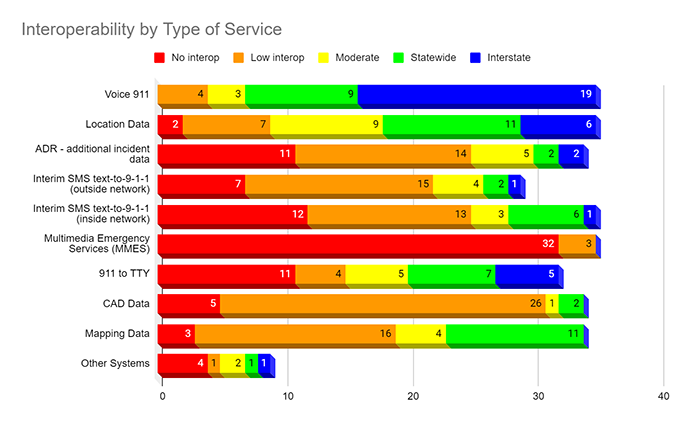This won’t come as news to anyone working in public safety communications, but 9-1-1 faces significant interoperability challenges. While ECCs are generally able to transfer basic voice 9-1-1 calls to neighboring ECCs, they often cannot share other types of communications and data important for emergency response.
What might be surprising is that ECCs face these interoperability challenges even in areas that are making progress deploying Next Generation 9-1-1 technologies. Perhaps that is why there has been increased attention to solving interoperability for 9-1-1 in recent years. As consumers, we take for granted that two people can communicate with all kinds of data, regardless of where they live, which companies provide the connectivity, the types of phones they’re using, or even whether one person is on a phone while the other is using a tablet. You would think that modernizing 9-1-1 technology would result in similar benefits, but that’s not proving to be the case. Now, a federal report helps to quantify the extent of interoperability problems in 9-1-1.
At APCO’s suggestion, the Federal Communications Commission directed the Communications Security, Reliability, and Interoperability Council (CSRIC) VII to survey the current state of interoperability for the nation’s 9-1-1 systems. CSRIC’s mission is to provide recommendations to the Commission on a variety of topics. On March 17, CSRIC adopted a “Report on the Current State of Interoperability in the Nation’s 911 Systems.” You can download the report on the CSRIC webpage.
The report describes the degree to which ECCs are able to share voice 9-1-1 calls, location data, SMS text-to-911, CAD data, and other types of data with other ECCs and (where appropriate) with emergency response providers. It relied on publicly available data, as well as responses to surveys distributed by APCO and the National Association of State 9-1-1 Administrators. APCO’s Chief Technology Officer served on the working group that developed the report.
This graphic from the report tells the story. Red and orange are bad – they represent zero or limited interoperability between ECCs for each type of communication/data. Green and blue are good – they represent interoperability statewide and interstate. There’s a lot more red and orange here than blue and green. In fact, unless you’re talking about the ability to transfer voice calls, ECCs are more likely than not to have an interoperability problem. That shouldn’t be the case.
ECCs should be able to receive location information with every transferred 9-1-1 call. They should be able to transfer texts to 9-1-1, CAD data, and other useful data relevant to an incident. The red and orange in this graphic represent obstacles to emergency response for public safety telecommunicators, police officers, EMTs, and firefighters. An already difficult job becomes harder.
What’s standing in the way of interoperability for 9-1-1? Proprietary technology. No doubt that the public safety communications community has benefited from some technology providers, including a number of newcomers, who are truly driven to introduce new innovations and make a difference. But we need to accept the reality that interoperability is a problem and work toward a solution.
One of APCO’s strategies has been to provide a Sample RFP Template for NG9-1-1 Capabilities to assist 9-1-1 directors and authorities with their procurement activities, whether for a statewide or local effort. The RFP Template covers all aspects of a complete NG9-1-1 deployment, regardless of the stage any state or locality is in concerning the transition to NG9-1-1. It offers recommendations, guidance, and specific operational requirements toward achieving several goals:
- Achieving interoperability among NG9-1-1 systems regardless of technology or jurisdiction;
- Promoting competitive and innovative solutions;
- Enabling the most cost-effective and operationally efficient solutions; and
- Ensuring these solutions include more than just an upgrade from analog based voice-only systems to true IP-based, multimedia capable systems and architectures.
Another strategy has been to advocate for federal funding to support the transition to NG9-1-1 nationwide, with requirements on funding recipients to achieve and maintain interoperability. This approach aligns with legislation that was introduced last year in the House and Senate that would create a $12 billion grant program for NG9-1-1. It’s worth noting that the definition of interoperability used in that legislation is identical to the definition in the CSRIC report.
Thanks to the FCC’s willingness to examine interoperability for 9-1-1 and the work of CSRIC’s members, we’re in a better position to solve this problem. APCO will continue working with policymakers at the Commission and Congress and pursuing every opportunity to ensure that ECCs can seamlessly exchange 9-1-1 calls and related data with other ECCs and on to responders in the field, regardless of jurisdictional boundaries, service provider, or other factors.

About the TabletopX Blog
A “Tabletop Exercise,” often shortened as “TTX,” is a discussion-based exercise frequently used by emergency planners. Led by a facilitator using a planned scenario, TTX participants describe the actions they would take, and the processes and procedures they would follow. The facilitator notes the players’ contributions and ensures that exercise objectives are met. Following the exercise, the facilitator typically develops an after-action report and conducts a debrief discussion during which players and observers have an opportunity to share their thoughts, observations, and recommendations from the exercise without assigning fault or blame.
Many of the attributes of a TTX are the same we seek to promote in the discussion generated from our blog posts. The goal is to capitalize on the shared experiences and expertise of all the participants to identify best practices, as well as areas for improvement, and thus achieve as successful a response to an emergency as possible.
TabletopX blog posts are written by APCO’s Government Relations team and special guests.
Latest TabletopX Posts
-
APCO’s Advocacy Priorities for 2024
-
More Information than You Ever Wanted about Fixing the Federal Classification of 9-1-1 Professionals
-
APCO’s Regulatory Priorities for 2023
-
APCO’s 2023 Advocacy Priorities (with one-pagers of talking points)
-
Regulatory Update from APCO’s Chief Counsel at APCO 2022
-
Talking Points for APCO’s Legislative Priorities